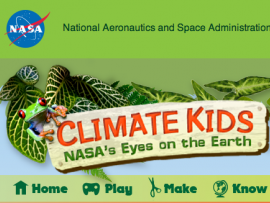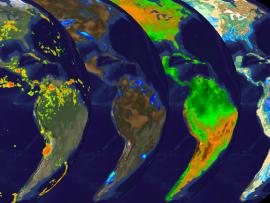Browse Energy Cycle Resources
Browse Energy Cycle Resources
Primary Topic:
Subtopics:
Type:
Summary:
Part 2 of a 4 part webquest that teaches the basics of precipitation science and technology. Prepares students for the GPM Anime Contest.
Primary Topic:
Subtopics:
Type:
Keywords:
Summary:
How do hurricanes get their energy? NASA hurricane scientist Dr. Jeff Halverson explains how hurricanes draw energy from the ocean surface.
Primary Topic:
Subtopics:
Type:
Keywords:
Standards:
Summary:
An educational website with activities, resources, and games to teach kids of all ages about Earth's systems, water cycle, weather and climate.
Primary Topic:
Subtopics:
Type:
Keywords:
Summary:
Explore how water moves across land and returns to the ocean in the final installment of the water cycle series. The visualizations illustrate the movement of water on land—from storage of precipitation in soil layers, to its transport via rivers.
Primary Topic:
Subtopics:
Type:
Keywords:
Summary:
Explore how water droplets form and fall from the sky in part three of the water cycle series. Watch how water vapor moves through the atmosphere and returns to Earth as rain and snow.
Primary Topic:
Subtopics:
Type:
Keywords:
Summary:
Explore water vapor in the air in part two of the water cycle series. This second part of our series on the water cycle illustrates the way in which evaporation and winds combine to move water from the ocean to the land.
Primary Topic:
Subtopics:
Type:
Keywords:
Summary:
Explore the solar heating of the ocean in part one of a series on the water cycle. The animations show multiple views of the solar heating of the oceans, a picture of this first stage of water's cyclical journey from sea to air to land, and back again.
Primary Topic:
Subtopics:
Type:
Standards:
Keywords:
Summary:
Water vapor - and with it energy - is carried around the globe by weather systems. This satellite image shows the distribution of water vapor over Africa and the Atlantic Ocean.
Primary Topic:
Subtopics:
Type:
Keywords:
Summary:
The cryosphere consists of those parts of the Earth's surface where water is found in solid form, including areas of snow, sea ice, glaciers, permafrost, ice sheets, and icebergs. This animation shows fluctuations in the cryosphere.
Primary Topic:
Subtopics:
Type:
Standards:
Keywords:
Summary:
A downloadable PDF lesson plan which explores Earth's energy cycle.











